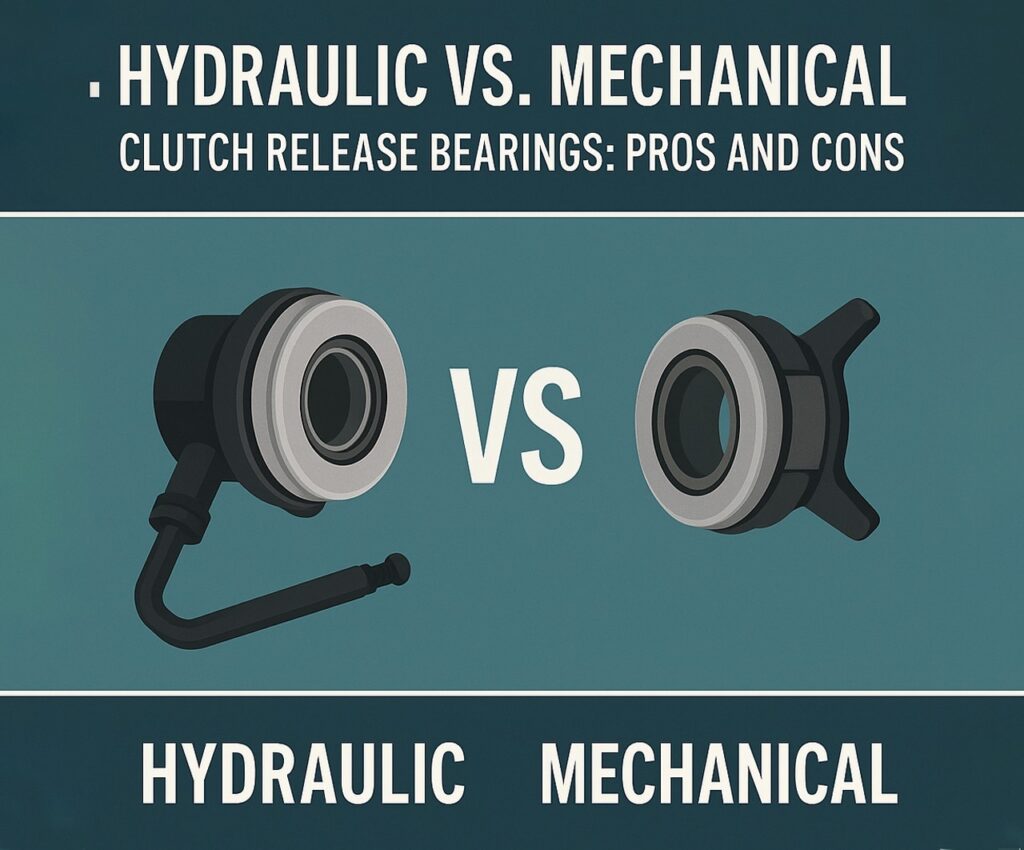If you’ve ever dealt with a noisy clutch release bearings, struggled while replacing clutch release bearing, or researched a hydraulic clutch release bearing upgrade, you’re not alone. The clutch release bearing may be small, but it plays a big role in smooth gear changes and overall driving comfort. Choosing between hydraulic and mechanical systems is critical—both have unique strengths and drawbacks depending on application, vehicle type, and user preference.
In this article, we break down both types, helping you make an informed decision for performance, maintenance, and long-term reliability. Know More
What is a Clutch Release Bearing?
A clutch release bearing, also called a throwout bearing, is the component that disengages the clutch when you press the pedal. It transfers the force from the clutch pedal (via a fork or slave cylinder) to the pressure plate, allowing the engine to separate from the transmission.
When a noisy clutch release bearing develops, it’s often a sign that the bearing is worn, improperly lubricated, or misaligned—leading to rough shifts or worse, total failure.
Mechanical Clutch Release Bearings
How They Work:
Mechanical systems use a clutch cable or linkage connected to a fork, which moves the release bearing manually when you press the pedal. It’s a direct, physical connection between driver and clutch.
Pros:
- Simple design: Easy to understand and service
- Lower cost: Affordable parts and labor
- No hydraulic fluid required: No worries about leaks or air bubbles
Cons:
- Inconsistent pedal feel: Cable stretch and wear affect performance
- More driver effort required: Especially in stop-and-go traffic
- Frequent adjustments needed: Especially with aging components
For those comfortable with occasional tweaking or driving vintage/manual cars, mechanical systems are familiar and manageable.
Hydraulic Clutch Release Bearings
How They Work:
A hydraulic clutch release bearing, often integrated with the slave cylinder, uses hydraulic pressure from the clutch master cylinder to operate the bearing. It delivers smoother and more consistent force.
Pros:
- Smooth pedal feel: Constant pressure means effortless clutch engagement
- Self-adjusting: No need to tune cable slack
- Ideal for high-performance vehicles: Cleaner, faster response
Cons:
- More complex: Requires regular fluid checks and bleeding
- Higher cost: Parts and labor tend to be pricier
- Failure can be sudden: If the system leaks or fails, you lose clutch control entirely
While the hydraulic clutch release bearing is modern and efficient, it demands higher maintenance awareness.
Common Problems
Noisy Operation:
A noisy clutch release bearing is a common complaint, usually heard as a whirring or grinding noise when the clutch pedal is pressed. Causes include:
- Worn-out bearing
- Misalignment
- Lack of lubrication
It’s a sign that replacing clutch release bearing should be a priority before deeper damage occurs.
Leaks (Hydraulic):
Hydraulic systems are vulnerable to leaks at the master cylinder, slave cylinder, or bearing seal. This can lead to total system failure.
Cable Stretch (Mechanical):
In mechanical setups, cables wear and stretch over time, requiring frequent adjustment or full replacement.
When Should You Replace the Clutch Release Bearing?
Replacing clutch release bearing is often recommended when:
- You’re replacing the clutch disc or pressure plate
- You hear noises during pedal operation
- The clutch feels rough or inconsistent
- You’re upgrading to a different clutch system (e.g., performance clutch)
Doing it early prevents damage to the pressure plate, flywheel, and transmission input shaft.
Which One is Right for You?
Choose Mechanical If:
- You own an older or economy car
- You prefer easier, more affordable maintenance
- You’re comfortable doing minor mechanical adjustments
Choose Hydraulic If:
- You drive a modern or performance vehicle
- You want a lighter, more responsive pedal
- You prioritize smoothness and reduced driver fatigue
If you’re battling a noisy clutch release bearing frequently, switching to a hydraulic clutch release bearing may reduce wear and offer longer-term reliability.
Installation and Cost
Replacing clutch release bearing generally requires transmission removal, which is labor-intensive. Costs can range from $300 to over $1,000 depending on vehicle type, labor rates, and whether other clutch parts are replaced at the same time.
Hydraulic systems may involve additional cost for fluid replacement, bleeding tools, and master/slave cylinder inspections.
Maintenance Tips
- For Hydraulic Systems:
- Check and top off fluid regularly
- Bleed system if you notice spongy pedal feel
- Inspect for leaks during oil changes
- For Mechanical Systems:
- Adjust clutch cable as needed
- Lubricate pivot points
- Replace stretched or frayed cables immediately
Keeping up with these basics prevents a noisy clutch release bearing and extends the life of the entire clutch assembly.
Future Trends
More manufacturers are adopting hydraulic clutch release bearing systems, especially for performance and electric vehicles with manual-like gearboxes. These systems integrate smart sensors to monitor wear, pressure, and engagement timing—making predictive maintenance easier.
But mechanical systems still have a stronghold in basic vehicles and motorcycles, where simplicity and cost remain king.
Final Thoughts
Whether you’re dealing with a noisy clutch release bearing, planning on replacing clutch release bearing, or considering a switch to a hydraulic clutch release bearing, understanding the pros and cons of each system is key. Mechanical bearings offer simplicity and control. Hydraulic ones offer precision and comfort.
Choose based on your driving habits, vehicle type, and maintenance preferences—and you’ll avoid the headaches that come from poor clutch performance.

